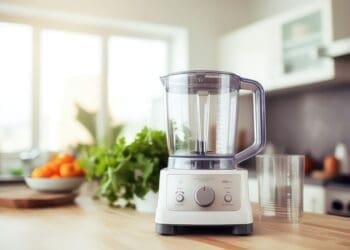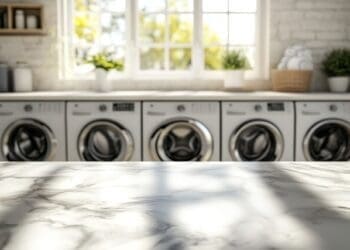We tested over 30 ice cream makers priced between $22 and $1,200 and found that there was a range of excellent options to create restaurant-quality frozen treats at home.
Modern ice cream makers come in various forms, from simple canister models to advanced compressor units. The Cuisinart ICE-21 produces dense, creamy ice cream in just 20 minutes, and premium options like the Ninja Creami Deluxe can create 11 different frozen desserts. These machines deliver quality that matches what you’d expect from professional kitchens.
Our team tested each machine with vanilla ice cream and strawberry sorbet to give you a full picture. We’ll help you select the perfect ice cream maker that fits your kitchen’s needs, whether you want a budget-friendly option or a commercial-grade powerhouse.
How Ice Cream Makers Work

Ice cream makers have evolved by a lot since Nancy Johnson invented them in 1843. Today’s machines use advanced technology to turn liquid ingredients into smooth, creamy frozen desserts. They do this through a precise mix of freezing and churning processes.
Simple Ice Cream Making Process
The basic process starts with an ice cream base that needs balanced ingredients: about 60% water, 15% sugar, 10% non-fat milk content, and 10-20% milk-fat content. The base then goes through dynamic freezing. This process freezes and stirs the mixture at the same time to create the right texture.
A rotating paddle keeps the mixture moving as it scrapes the frozen mix from the canister’s walls. This constant motion does two important things: it stops large ice crystals from forming and adds tiny air bubbles to the mixture. The best results come when ice crystals stay smaller than 50μm.
Air content, known as overrun, shapes the final texture. More air creates lighter, fluffier ice cream, while less air leads to denser, creamier frozen desserts. Professional ice cream makers check consistency through several methods:
- Mix temperature tracking
- Refrigeration system pressure monitoring
- Force measurement needed for beater movement
Freezing Bowl vs Compressor Technology
We used two main freezing technologies in modern ice cream makers. The first type needs a pre-frozen bowl filled with coolant, while the second uses a built-in compressor system.
Freezer bowl models, like the Cuisinart ICE-30BC, need bowl pre-freezing at about -30°C (-22°F). These machines reach bowl wall temperatures between -23°C to -29°C (-9.4°F to -20.2°F) and take around 32 minutes to churn a 700ml batch.
Compressor models include a complete refrigeration system with four parts: compressor, condenser, expansion valve, and evaporator. These self-cooling units can get as cold as -22°F (-30°C). Their biggest advantage is making multiple batches back-to-back without pre-freezing.
The freezing happens in two stages. Dynamic freezing combines freezing and stirring to create the first ice crystals. Static freezing follows, where the partly frozen ice cream hardens without stirring until it reaches -18°C (-0.4°F), or better yet, -25°C to -30°C (-13°C to -22°F).
Temperature control is vital throughout the process. The ice cream base enters the machine just above its freezing point. A layer of ice forms on the cold bowl wall and starts rapid nucleation – creating small ice crystals. The rotating dasher blades scrape these crystals off and mix them with the warmer mixture in the bowl’s center.
Residence time – how long the mix stays in the machine – affects crystal size distribution. Less time usually means smaller ice crystals and smoother texture. Professional machines typically reach draw temperatures (when ice cream comes out) between -5 to -6°C (23 to 21.2°F).
Storage after churning affects the final product’s quality. Quick cooling during static freezing creates smaller ice crystals. Steady storage temperatures help prevent recrystallization and make the ice cream last longer.
Top Ice Cream Makers Under $100

Professional-quality ice cream makers don’t have to break the bank. Our tests show several excellent options under $100 that make delicious frozen treats at home.
Best Overall: Cuisinart ICE-21
The Cuisinart ICE-21 stands out among its peers producing dense, creamy ice cream in approximately 17-20 minutes. This compact powerhouse costs around $50 and fits nicely in most kitchens with its 9.5x9x11.25-inch size and 11-pound weight.
The design is simple yet effective. A double-walled freezer bowl with special coolant needs 16-24 hours of pre-freezing. The wait time pays off because the ICE-21 makes ice cream much faster than its competitors. Most machines with built-in cooling systems take at least 40 minutes.
The churning mechanism really shines. It adds just the right amount of air and prevents ice crystals, which results in smooth, creamy ice cream every time. The 1.5-quart bowl works great for most families. Just don’t fill it too much since the churning adds volume to your final treat.
The ICE-21’s smart features make it easy to use:
- A wide spout to add ingredients
- A clear lid to watch the process
- Non-slip rubber feet for stability
- A spot to store the cord
- BPA-free parts
Best Budget Pick
The DASH My Pint Electric Ice Cream Machine gives you great value at just $22. This tiny powerhouse weighs less than a pound but makes surprisingly smooth frozen desserts.
You can make about 1.6 cups of ice cream in 30 minutes – perfect for small households or single servings. The portions might be small, but the quality is impressive. Let it set in the freezer for an hour and you’ll be amazed by the results.
Best for Small Kitchens
The Cuisinart ICE-21 works well in tight spaces, but the DASH My Pint is even better when space is really limited. Its modern look comes in aqua and white, making it perfect for apartments, dorms, or RV kitchens.
These budget machines make ice cream that tastes like it came from a restaurant. The Cuisinart ICE-21 creates treats that match machines costing ten times more. The ice cream comes out smooth and chewy. Chilling your ingredients beforehand makes it even better.
Cleaning these machines is a breeze. The Cuisinart ICE-21’s parts need just a quick rinse, though they aren’t dishwasher-safe. A 3-year limited warranty gives you confidence in its quality.
Tips to get the best from your budget ice cream maker:
- Give the bowl enough freezing time (16-24 hours minimum)
- Cool your ice cream base first
- Save mix-ins for the end of churning
- Let the ice cream harden in the freezer until it’s scoop-ready
Your fresh ice cream will be soft-serve consistency at first, but a few hours in the freezer will make it perfectly scoop-able without losing its smooth texture. With the right technique and a little patience, these affordable machines create frozen desserts worthy of an ice cream shop.
Premium Ice Cream Makers Worth the Investment

Serious ice cream enthusiasts who want professional-quality results should invest in a premium ice cream maker. These machines deliver exceptional results and unmatched consistency. Their high-end features and performance justify the steeper price tags.
Commercial-Grade Options
The Lello Musso Lussino leads the pack in home ice cream making excellence. This stainless steel masterpiece from Italy creates ice cream that rivals artisanal scoop shops. The machine’s reliable construction has an all-metal paddle system that sets it apart from competitors using plastic components.
The Lello 4080 Musso Lussino has a simple interface with dedicated switches for churning and cooling. A timer knob gives precise control. The original batches need about 50% more time than canister models. Later batches reach perfect consistency in just 20 minutes.
The Breville Smart Scoop brings advanced features at a more available price point. This sophisticated machine has 12 distinct hardness settings that are fine-tuned for different frozen desserts. Internal thermometers monitor mixture temperature constantly and adjust the compressor to keep ideal consistency.
The Cuisinart ICE-100 strikes a sweet spot among compressor-based machines. This reliable unit makes 1.5 quarts of ice cream in under an hour. Our tests showed it creates incredibly smooth sorbets in just 41 minutes.
High-End Features That Matter
Premium ice cream makers have several key features that raise their performance:
Built-in Compressors: Unlike simple models that need pre-frozen bowls, high-end machines use compressor systems like household freezers. You can make multiple batches without waiting between cycles.
Temperature Management: Advanced models like the Breville Smart Scoop keep precise temperature control during churning. The “keep cool” function maintains finished ice cream at perfect serving temperature for up to three hours.
Construction Quality: The Lello Musso Lussino shows superior build quality with its stainless steel parts and hand-assembled design. This durability gives consistent performance for years.
The Whynter ICM-201SB offers great value as a more affordable premium option. It costs much less than the Lello but creates similarly textured ice cream. The removable bowl makes cleaning easier.
These premium machines shine at:
- Keeping consistent temperatures throughout churning
- Creating exceptionally smooth textures with minimal ice crystals
- Making various frozen desserts
- Delivering reliable performance with frequent use
A premium ice cream maker proves especially valuable if you:
- Keep taking ice cream regularly
- Want professional-quality results
- Need to make multiple batches back-to-back
- Care about precise control over consistency and texture
The Breville Smart Scoop’s pre-cool function lets you chill the bowl while preparing ingredients. Its 12 hardness settings help fine-tune different frozen desserts, from soft sorbet to firm ice cream.
The Lello Musso Lussino costs around $700, placing it at the top of home ice cream makers. Its commercial-grade construction and superior performance make it perfect for serious enthusiasts or small-scale artisanal production.
Getting Restaurant-Quality Results

You need to become skilled at essential techniques beyond basic recipes to make professional-quality ice cream. My extensive testing and expert knowledge has helped me identify what makes homemade frozen treats taste like they’re from a restaurant.
Professional Churning Techniques
Great ice cream starts with proper churning. Let your ice cream base rest in the refrigerator overnight – this step makes the final texture much better. The base should cool to about 40°F before you start churning.
Your freezer temperature plays a vital role if you use machines with removable bowls. A freezer set to -30°C (-22°F) will give you the best bowl wall temperatures between -23°C to -29°C. This cuts churning time to just 32 minutes for a 700ml batch. Use your freezer’s “super freeze” function whenever you can.
Here’s a pro tip many people miss: cover your freezer bowl with cling film before freezing. This stops water vapor and ice from building up inside and prevents texture problems during churning.
Temperature Control Tips
Getting the right temperature throughout the process is vital to achieve restaurant-quality results. Your custard bases should hit 170°F – you can test this with a wooden spoon. The custard is ready when it coats the back of the spoon and lets you draw a clean line through it.
Put your ice cream in pre-chilled containers right after churning. Cool these containers in the freezer for just 30 minutes before you need them. This keeps your ice cream frozen and stops it from melting too soon, which could ruin its texture.
Don’t microwave hard ice cream when serving. Let it sit in the refrigerator for 20 minutes instead. This gives you the perfect scooping consistency and softens the ice cream evenly without damaging its texture.
Mix-In Timing Guide
Adding mix-ins takes perfect timing and preparation. Add about 3/4 to 1 cup of mix-ins for each quart of ice cream. Each piece should be about the size of a chocolate chip to spread evenly through the ice cream.
Sift chopped nuts, cookies, or other mix-ins through a fine-mesh strainer to avoid grittiness. Chill these ingredients while your ice cream churns so they don’t cause melting when mixed in.
The Italian straciatella technique works great for chocolate additions. Drizzle warm chocolate mixed with a teaspoon of neutral oil per two ounces into churning ice cream during the final minutes. This creates perfect chocolate shards that melt smoothly in your mouth.
Timing matters when you add swirls of caramel, fudge, or jam. Layer them between portions of churned ice cream in your storage container instead of adding them during churning. This creates beautiful, distinct swirls throughout your ice cream.
Mix delicate ingredients like fresh fruit or cake pieces by hand after churning. This keeps them intact while spreading them evenly through the ice cream.
High-end ice cream shops keep their overrun (air incorporation) between 22-25%, while cheaper products might go up to 100%. Keep your overrun low in homemade batches to get that dense, premium texture you find in quality ice cream shops.
Common Ice Cream Making Mistakes

Even experienced home ice cream makers run into challenges that can affect their frozen treats. You’ll get better results from your ice cream maker when you know these common problems.
Bowl Temperature Issues
Your freezer bowl’s temperature is the key to making great ice cream. A bowl that isn’t cold enough will give you soupy ice cream, no matter how good your recipe is. The freezer bowl needs to reach temperatures between -23°C to -29°C (-9.4°F to -20.2°F) to work properly.
Most ice cream makers with removable bowls have special coolant that must freeze completely. You can tell if the bowl is ready by shaking it – if you hear liquid moving around, it needs more time in the freezer. The bowl needs at least 24 hours in the freezer at -18°C or below to get cold enough.
Here’s what can stop your bowl from getting cold enough:
- Running it through a dishwasher – high heat damages the freezing gel inside
- Not keeping it at steady temperatures
- Taking it out of the freezer too soon
- Not using an airtight freezer bag to store it
Your pre-frozen bowl starts warming up as soon as you take it out of the freezer. You’ll need to work fast once you start churning. The ice cream mixture should be around 4°C (39°F) when you pour it in.
Ingredient Ratio Problems
Getting the perfect texture depends on using the right amount of each ingredient. Professional ice cream usually has 22-25% air mixed in, while cheaper products might have up to 100% air. Fat content really matters too – trying to make “healthier” ice cream by cutting fat usually doesn’t work well.
Sugar and fat work together to control how the ice cream freezes. Too much sugar or alcohol will keep it from freezing properly, while too little sugar makes it rock-hard. Here’s what works best:
- 60% water content
- 15% sugar
- 10% non-fat milk content
- 10-20% milk-fat content
Temperature control shapes how ice crystals form. Your ice cream base must be chilled to 4°C (39°F) before churning. A warm mixture makes your machine work harder and can create large ice crystals that make the texture grainy.
How you store your ice cream after churning matters just as much. Quick freezing creates smaller ice crystals. Cold storage containers help keep the consistency right when you move the ice cream from machine to freezer.
For custard-based recipes, heat the mixture to exactly 170°F so the eggs thicken without curdling. A thermometer takes out the guesswork and helps you get consistent results. After cooking, let the base chill overnight in the fridge.
When you add mix-ins makes a big difference. Adding them too early messes up the freezing, but too late means they won’t mix well. The best time to add extras is during the last few minutes of churning. Make sure these ingredients are cold to prevent melting spots that could ruin the texture.
Adding stabilizers like gelatin or pectin (1/4 teaspoon per 500ml of base) helps stop ice crystals from forming. These work really well in recipes with lots of water or ice cream you plan to store for a while.
Your specific machine has its own quirks you should know about. Compressor models might need 15 minutes to cool down before you add your mixture. Stopping the machine while it’s churning can also affect how the compressor works and change your ice cream’s texture.
Maintenance and Care Guide

Your ice cream maker will last longer and work better with proper maintenance. I’ve tested many models and found several care practices that keep these machines running smoothly.
Cleaning Best Practices
You need to clean your machine daily to keep it working well. Machines without built-in cleaning cycles need special attention. Start by removing leftover ice cream and rinse with warm water until the water runs clear. Mix a specialized cleaner like Citranox (2 cups per 4 gallons of warm water) to get a full clean.
Here are three vital steps to clean your machine:
- Take apart removable parts based on your manual
- Let components soak in cleaning solution for 10 minutes
- Clean internal surfaces with food-grade sanitizer
Check and replace damaged seals and O-rings after cleaning, then put everything back together. Don’t forget to lubricate parts as your machine’s manual specifies. The best way to sanitize is to use both detergents and sanitizers – detergents clean visible dirt, while sanitizers kill hidden bacteria.
Storage Tips
The way you store your ice cream maker affects its life by a lot. If you have a freezer bowl model, keep the bowl in an airtight freezer bag at -18°C or below. This stops moisture from building up and keeps the freezing process efficient.
Here’s what works best when storing homemade ice cream:
- Put plastic wrap right on the ice cream’s surface
- Use freezer-specific containers
- Keep your freezer temperature steady to avoid ice crystals
Compressor models need a clean, dry spot with good airflow. The condenser coils must stay dust-free to cool properly.
When to Replace Parts
Regular checks help you spot parts that need replacement. Here are the core components that need attention:
O-rings and Plunger Seals: New ones every 6 weeks stop leaks and keep things running smoothly. Head O-rings usually last a year.
Scraper Blades: Check once a year and replace based on how much you use them. These parts control how much air gets into your ice cream. You can test the blades easily – they need replacement if they don’t resist much.
Shaft Seals: Replace these each season so product doesn’t leak into your machine’s inner parts. This step is vital for safety and machine life.
Duck Bill Valves: Replace yearly in pressurized systems to keep mix flowing right and stop backflow. Star nozzles also need yearly replacement for even dispensing.
Door Gaskets: Keep an eye on these since they keep the cold air in. Replace them right away if you see any damage.
Here’s how to get the best results:
- Get spare parts before the season starts
- Clean as often as the manufacturer says
- Keep records of maintenance and new parts
- Fix small problems quickly before they get bigger
Your ice cream maker can work great for years with good care and timely part changes. A regular cleaning schedule and proper storage will help you make consistently good ice cream.





















































